Composting toilets present a sustainable alternative to traditional bathroom fixtures. These units are an ingenious solution for areas without sewer systems or for those looking to reduce water usage and their ecological footprint.
Unlike conventional toilets, composting toilets use little to no water and instead rely on the natural process of decomposition to manage waste. By converting human waste into compost, these toilets can be a key component in the cycle of reuse and sustainability.
I evaluated numerous models on their design, user-friendliness, and effectiveness at managing waste. By focusing on essential attributes, I was able to determine which composting toilets stand out in the market. That is why my analysis aims to provide valuable insights to assist in selecting a composting toilet that meets the balance of sustainability, functionality, and convenience.
I can attest to Separett Villa’s flawless performance. Its waterless design aligns perfectly with eco-conscious practices, making it both practical and environmentally friendly. The unit’s ability to divert urine aids significantly in reducing odor and accelerates the composting process, making the experience almost akin to using a regular flush toilet. Putting this composting toilet to use has been relatively straightforward. It’s refreshing to not worry about the nuances of composting on-site. By simply removing the compostable liner bag every few weeks, based on usage, the process is kept clean and efficient, integrating seamlessly with my routine cabin maintenance. The dual power functionality is a standout, ensuring consistent operation regardless of fluctuating power sources. The fan that comes with it is quiet and effective, preventing any unwanted odors from lingering. For all these reasons, Separett Villa 9215 remains my top pick and the best one in the market in my humble opinion.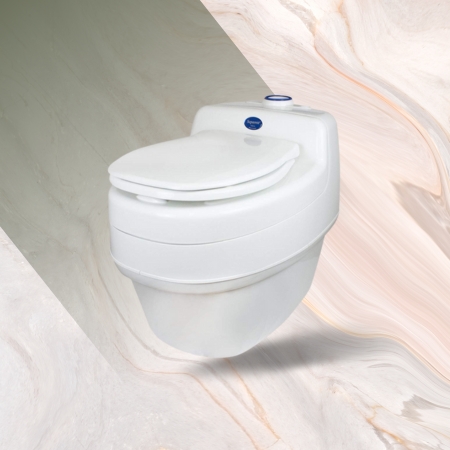
![]() Price Range:$984,99- $999,95
Price Range:$984,99- $999,95
2. Nature’s Head Self Contained
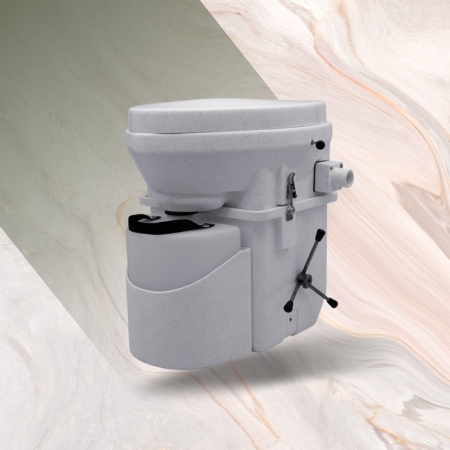
I used to own Nature’s Head Self Contained, In my time with this option, what stood out most was the lack of any foul smell—an often unpleasant companion in the world of portable toilets. I found myself impressed with the solidity of the construction as well. It’s clear that this isn’t a makeshift solution, but rather a well-thought-out product designed with end-users in mind.
Talking about maintenance, the simplicity shines through again. It took me a matter of minutes to empty, without any mess or fuss. The composting action seems to work just as advertised, rendering waste into a non-offensive material that can be disposed of responsibly.
The instructional aspect isn’t to be taken lightly, however. If you’re unfamiliar with composting toilets, set aside some time to understand the system fully. This is crucial to enjoy the full range of benefits Nature’s Head offers without hiccups.
- Straightforward installation process
- Zero odor emissions
- Impressive capacity
- Higher upfront investment
- Somewhat complex maintenance
3. Separett Tiny
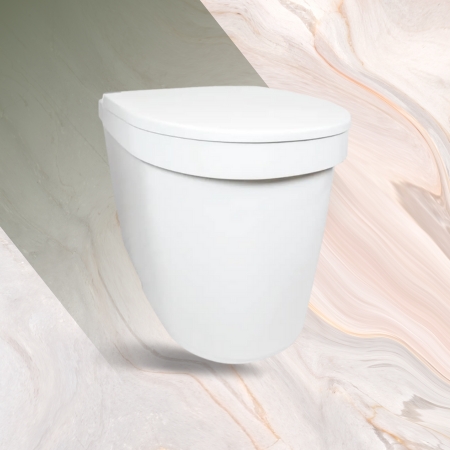
Separett Tiny is a serious space saver, designed with a modicum of finesse, which means it doesn’t stick out like a sore thumb. The overall user experience is quite straightforward, and after a few weeks of use, it became clear that the Separett Tiny can handle regular use without any hiccups.
Maintaining this composting toilet is pretty easy, although I have to empty the solid waste once a week and the urine container even more frequently. This regular maintenance is worth it, though, because it doesn’t emit bad odors thanks to its effective urine-diverting system and silent fan that keeps the air clean and fresh.
The price can be a little steep at first glance, but when you weigh that against the convenience and the cost savings in water bills, it’s well worth the investment for me. The Separett Tiny is a testament to how innovative design can make off-grid living or small spaces much more comfortable without compromising on hygiene or comfort.
- Tailor-made for small living areas and easy to install
- Great odor management system
- Design discreetly conceals waste, ensuring a neat appearance
- Needs regular maintenance
- The initial cost might be steep for some budgets
4. OGO Compost Toilet
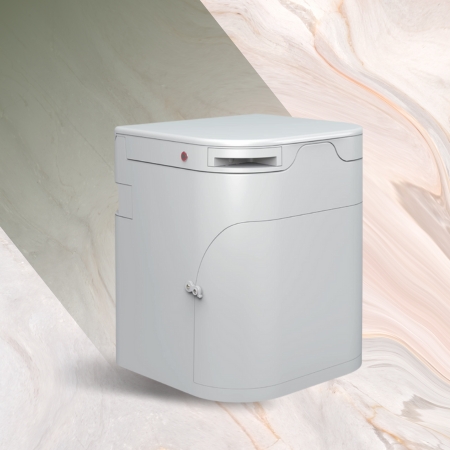
I immediately noticed how snugly OGO Compost Toilet fits even in the tight spaces of my van. Its small footprint is indeed a game-changer for those of us with limited square footage. While the composting toilet shines with its compactness and ease of use, it does bring a few challenges. For example, while the urine diverter is a hygienic feature, it’s not the most comfortable for men to use. Additionally, the contraption’s material doesn’t exude the same sturdiness you might expect from heftier units.
On the duty of maintenance, the OGO makes emptying the waste simple with a detachable solids bin and a large urine bottle. I found the entire process to be straightforward without any spillage. For anyone residing in a tiny home or leading a mobile lifestyle, the convenience of not having to deal with black tanks or dump stations is invaluable.
- Compact design suitable for small spaces
- Simplified waste disposal process
- Built-in electric mixer facilitates composting
- Build feels less robust compared to some alternatives
- Urine diverting design may be challenging for males
- Requires consistent maintenance and emptying
Buying Guide
Now, let me talk about some of the factors you need to consider before you purchase a composting toilet.
Considerations for Capacity
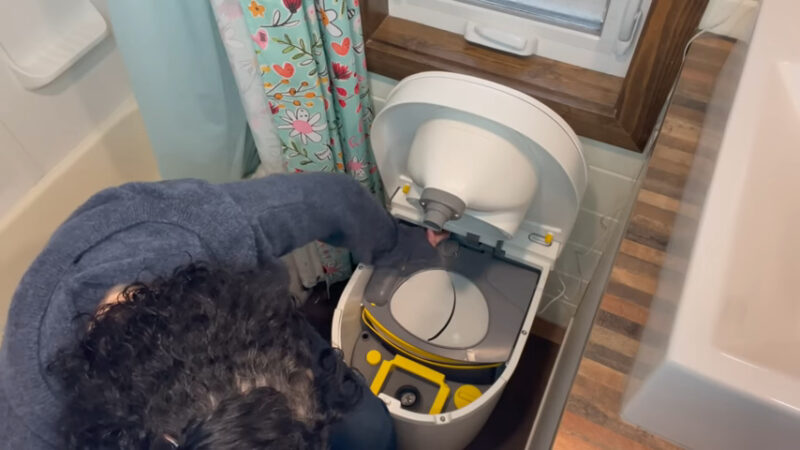
Understanding the capacity requirement is crucial. This involves considering the size of your household and the anticipated frequency of use, which are pivotal in ensuring that the chosen model aligns with your lifestyle and minimizes the need for constant maintenance.
- Single Users or Couples:
-
- Opt for Smaller Units: If you’re living alone or with a partner, a composting toilet with a smaller capacity is usually sufficient. These units are designed to handle a lower volume of waste, making them ideal for fewer users.
- Benefits: Besides being more compact and space-efficient, these smaller units are often more affordable and easier to manage in terms of cleaning and emptying.
- Families or Higher Usage Scenarios:
-
- Requirement for Larger Capacity: For families or situations where the toilet will be used more frequently (such as in a shared house or during gatherings), opting for a composting toilet with a larger capacity is essential. You should look for the same characteristics in tumblers and bins.
- Considerations: Larger capacity toilets may require more space and could be more expensive, but they offer the convenience of less frequent maintenance.
Material and Durability
The selection of materials in the construction of a composting toilet is a critical factor that directly influences its durability, maintenance requirements, and overall lifespan. High-quality materials not only ensure the toilet withstands regular use but also affect its functionality and ease of upkeep.
- Stainless Steel:
-
- Robustness: Stainless steel is renowned for its strength and durability. It can withstand the rigors of daily use without succumbing to rust or corrosion, which is particularly important in the moist environment of a bathroom.
- Ease of Cleaning: One of the significant advantages of stainless steel is its ease of cleaning. Its smooth surface resists stains and odors, making it simpler to maintain a hygienic composting toilet.
- Aesthetic and Longevity: Stainless steel also offers a sleek, modern look that can complement various interior designs. Its ability to maintain appearance over time adds to the long-term value of the composting toilet. The same could be said about bins, and layering the compost in them.
- Durable Plastics:
-
- Lightweight Nature: Durable plastics are often chosen for their lightweight properties, making the installation and potential relocation of the composting toilet easier. This is particularly beneficial in tiny houses or mobile homes where weight and portability are considerations.
- Cost-Effectiveness: Generally, high-quality plastics are more affordable than stainless steel. This makes composting toilets accessible to a broader range of budgets without significantly compromising on quality.
- Variety and Design Flexibility: Plastics offer a wide range of design options and can be molded into various shapes and sizes, allowing for more customization in the design of the composting toilet.
Ease of Installation

When it comes to choosing a composting toilet, understanding the capacity requirement is crucial. This involves considering the size of your household and the anticipated frequency of use, which are pivotal in ensuring that the chosen model aligns with your lifestyle and minimizes the need for constant maintenance.
- Single Users or Couples:
-
- Opt for Smaller Units: If you’re living alone or with a partner, a composting toilet with a smaller capacity is usually sufficient. These units are designed to handle a lower volume of waste, making them ideal for fewer users.
- Benefits: Besides being more compact and space-efficient, these smaller units are often more affordable and easier to manage in terms of cleaning and emptying.
- Families or Higher Usage Scenarios:
-
- Requirement for Larger Capacity: For families or situations where the toilet will be used more frequently (such as in a shared house or during gatherings), opting for a composting toilet with a larger capacity is essential. This ensures that the system can handle a higher volume of waste without the need for frequent emptying.
- Considerations: Larger capacity toilets may require more space and could be more expensive, but they offer the convenience of less frequent maintenance. This is particularly important in a busy household where the toilet sees constant use.
Ventilation System
An effective system not only minimizes odors but also contributes to the proper composting process. When evaluating composting toilets, I pay close attention to the efficiency and design of the ventilation system, focusing on two key aspects: airflow and noise level.
- Air Flow:
-
- Sufficient Ventilation: The primary function of the ventilation system is to ensure adequate air flow, which is crucial for mitigating odors.
- Design Considerations: The effectiveness of the ventilation system depends on its design. It should be capable of handling the volume of air necessary for the size of the toilet and the frequency of use.
- Noise Level:
-
- Quiet Operation: While effective ventilation is crucial, it’s also important that the system operates quietly. A loud ventilation fan can be disruptive, especially in a small space like a tiny house or a compact bathroom.
- Quality of Components: The noise level often depends on the quality of the fan and other components of the ventilation system. Higher-quality fans tend to operate more quietly while still providing efficient airflow.
User Maintenance
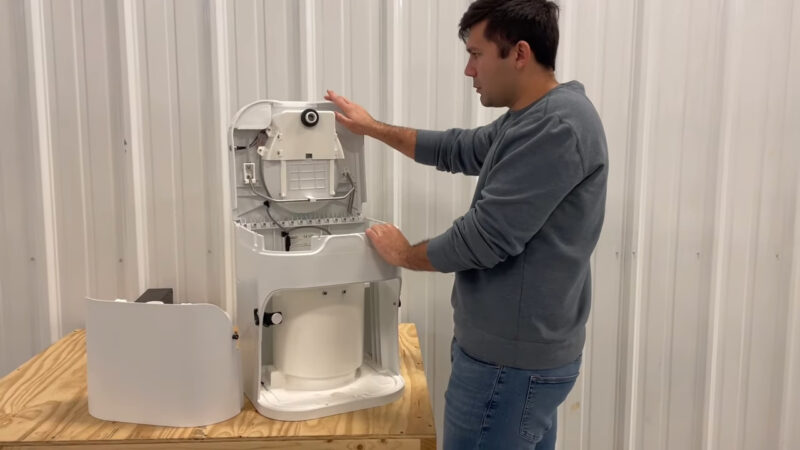
When evaluating composting toilets, the ease of maintenance is a crucial factor that directly impacts user satisfaction and the practicality of the system.
Regular maintenance, including emptying and cleaning, is essential for the efficient operation and hygiene of the composting toilet. I focus on two main aspects of maintenance: the ease of emptying the system and the simplicity of cleaning.
- Ease of Emptying:
-
- Frequency of Emptying: Ideally, a composting toilet should require less frequent emptying. This depends on the capacity of the system and the number of users.
- Simplicity of the Process: The process of emptying the composting toilet should be straightforward and hassle-free. The goal is to make this task as clean and effortless as possible to encourage regular maintenance.
- Cleaning Ease:
-
- Surface Design: The surfaces of the composting toilet, both interior and exterior, should be designed for easy cleaning. Materials that allow for a simple wipe-down are preferable.
- Accessibility for Cleaning: The design of the toilet should also facilitate easy access to all parts that require regular cleaning. This includes the bowl, any screens or filters, and the area around the waste container.
FAQs
Check out more similar products if those above aren’t your cup of tea:
The Bottom Line
In my assessment of composting toilets, it’s evident that they present a sustainable solution for waste management. They significantly reduce water usage, a key benefit in areas where water is scarce. Composting toilets also provide a means to convert human waste into beneficial compost, which can be an excellent resource for gardening.
Costs can vary, from high-end designs to more economical models, ensuring there’s an option for various budgets. My research confirms that maintenance is crucial; regular upkeep is necessary to avoid odors and ensure proper composting. When properly managed, these toilets are odorless and hygienic. Users must be informed and committed to following the necessary processes.
Related Posts:
- Advantages & Disadvantages of Composting Toilets:…
- 10 Best Books on Climate Change in 2024 - In-Depth…
- 5 Best Tumbling Composters for Your Garden in 2024 -…
- 10 Best Eco-Friendly Water Bottles in 2024:…
- Compost 101: A Beginner's Guide to Organic Composting
- 10 Hottest States in the US in 2024 - Heatwave Alert













